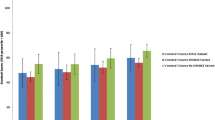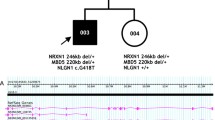Abstract
Linkage and cytogenetics studies have found the Angelman syndrome (AS) chromosomal region to be of relevance to autism disorder (AD) or autism spectrum disorder (ASD). Autism is considered part of the behavioural phenotype in AS based on formal autism assessments (autism diagnostic interview—revised [ADI-R] and autism diagnostic observation schedule [ADOS]), which have mainly addressed the deleted AS group. We explored 23 AS patients including all genetic subtypes and made a co-morbid diagnosis of AD/ASD in 14/23 (61%), which does not include 4 cases classified within the broader autism spectrum disorder (bASD). Deletions accounted for the main fraction (35%), ubiquitin-protein ligase E3A (UBE3A) mutation represented 13%, imprinting defects and uniparental disomy 9 and 4%, respectively. UBE3A mutations due to lack of the homologous to the E6-associated protein carboxyl terminus domain (n = 3) were associated with the ASD, while more distal mutations (n = 3) seem to escape from a co-morbid diagnosis of autism/autism spectrum. Differences in severity of autistic features were seen across subtypes of AS, with some behavioural features being unique to AS and some representing all forms of developmental disability. Autism signs (poor/lack of eye contact, showing, spontaneous initiation of joint attention, social quality of overtures [ADOS algorithm items for Diagnostic and Statistical Manual of Mental Disorders—IV (DSM-IV)/International Statistical Classification of Diseases and Related Health Problems—10 (ICD-10) autism diagnosis belonging to the reciprocal social interaction domain]) discriminating all the co-morbid AS categories from non-autistic AS belonged to the social interaction domain. Impairments in the communication domain (gestures, pointing, use of another’s body, frequency of vocalisation towards others [ADOS algorithm items for DSM-IV/ICD-10 autism diagnosis belonging to the communication domain]) justified classification of co-morbid AD/ASD vs the classification of less affected bASD. Evaluation of the behaviour domain suggested that repetitive sensory and motor behaviours correlate with a low developmental profile rather than being specific to autism.


Similar content being viewed by others
References
Williams CA, Beaudet AL, Clayton-Smith J, Knoll JH, Kyllerman M, Laan LA, Magenis RE, Moncla A, Schinzel AA, Summers JA, Wagstaff J (2006) Angelman syndrome 2005: updated consensus for diagnostic criteria. Am J Med Genet A 140:413–418. DOI 10.1002/ajmg.a.31074
Clayton-Smith J, Laan L (2003) Angelman syndrome: a review of the clinical and genetic aspects. J Med Genet 40:87–95
Horsler K, Oliver C (2006) Environmental influences on the behavioral phenotype of Angelman syndrome. Am J Ment Retard 111:311–321. DOI 10.1352/0895-8017
Berry RJ, Leitner RP, Clarke AR, Einfeld SL (2005) Behavioral aspects of Angelman syndrome: a case control study. Am J Med Genet 132A:8–12. DOI 10.1002/ajmg.a.30154
Horsthemke B, Buiting K (2006) Imprinting defects on human chromosome 15. Cytogenet Genome Res 113:292–299. DOI 10.1159/000090844
Rougeulle C, Cardoso C, Fontes M, Colleaux L, Lalande M (1998) An imprinted antisense RNA overlaps UBE3A and a second maternally expressed transcript. Nat Genet 19:15–16
Varela MC, Kok F, Otto PA, Koiffmann CP (2004) Phenotypic variability in Angelman syndrome: comparison among different deletion classes and between deletion and UPD subjects. Eur J Hum Genet 12:987–992. DOI 10.1038/sj.ejhg.5201264
Lossie AC, Whitney MM, Amidon D, Dong HJ, Chen P, Theriaque D, Hutson A, Nicholls RD, Zori RT, Williams CA, Driscoll DJ (2001) Distinct phenotypes distinguish the molecular classes of Angelman syndrome. J Med Genet 38:834–845
Sahoo T, Peters SU, Madduri NS, Glaze DG, German JR, Bird LM, Barbieri-Welge R, Bichell TJ, Beaudet AL, Bacino CA (2006) Microarray based comparative genomic hybridization testing in deletion bearing patients with Angelman syndrome: genotype–phenotype correlations. J Med Genet 43:512–516. DOI 10.1136/jmg.2005.036913
Cook EH, Courchesne RY, Cox NJ, Lord C, Gonen D, Guter SJ, Lincoln A, Nix K, Haas R, Leventhal BL, Courchesne E (1998) Linkage-disequilibrium mapping of autistic disorder, with 15q11–13 markers. Am J Hum Genet 62:1077–1083
Nurmi EL, Bradford Y, Chen Y, Hall J, Arnone B, Gardiner MB, Hutcheson HB, Gilbert JR, Pericak-Vance MA, Copeland-Yates SA, Michaelis RC, Wassink TH, Santangelo SL, Sheffield VC, Piven J, Folstein SE, Haines JL, Sutcliffe JS (2001) Linkage disequilibrium at the Angelman syndrome gene UBE3A in autism families. Genomics 77:105–113. DOI 10.1006/geno.2001.6617
Curran S, Powell J, Neale BM, Dworzynski K, Li T, Murphy D, Bolton PF (2006) An association analysis of candidate genes on chromosome 15 q11–13 and autism spectrum disorder. Mol Psychiatry 11:709–713. DOI 10.1038/sj.mp.4001839
Repetto GM, White LM, Bader PJ, Johnson D, Knoll JH (1998) Interstitial duplications of chromosome region 15q11q13: clinical and molecular characterization. Am J Med Genet 79:82–89
Gurrieri F, Battaglia A, Torrisi L, Tancredi R, Cavallaro C, Sangiorgi E, Neri G (1999) Pervasive developmental disorder and epilepsy due to maternally derived duplication of 15q11–q13. Neurology 52:1694–1697
Thomas NS, Browne CE, Oley C, Healey S, Crolla JA (1999) Investigation of a cryptic interstitial duplication involving the Prader–Willi/Angelman syndrome critical region. Hum Genet 105:384–387. DOI 10.1007/s004399900159
Bolton PF, Dennis NR, Browne CE, Thomas NS, Veltman MW, Thompson RJ, Jacobs P (2001) The phenotypic manifestations of interstitial duplications of proximal 15q with special reference to the autistic spectrum disorders. Am J Med Genet 105:675–685. DOI 10.10012/ajmg.1551
Baron CA, Tepper CG, Liu SY, Davis RR, Wang NJ, Schanen NC, Gregg JP (2006) Genomic and functional profiling of duplicated chromosome 15 cell lines reveal regulatory alterations in UBE3A-associated ubiquitin-proteasome pathway processes. Hum Mol Genet 15:853–869. DOI 10.1093/hmg/ddl004
Samaco RC, Hogart A, LaSalle JM (2005) Epigenetic overlap in autism-spectrum neurodevelopmental disorders: MECP2 deficiency causes reduced expression of UBE3A and GABRB3. Hum Mol Genet 14:483–492. DOI 10.1093/hmg/ddi045
Makedonski K, Abuhatzira L, Kaufman Y, Razin A, Shemer R (2005) MeCP2 deficiency in Rett syndrome causes epigenetic aberrations at the PWS/AS imprinting center that affect UBE3A expression. Hum Mol Genet 14:1049–1058. DOI 10.1093/hmg/ddi097
Steffenburg S, Gillberg CL, Steffenburg U, Kyllerman M (1996) Autism in Angelman syndrome: a population-based study. Pediatr Neurol 14:131–136
Thompson RJ, Bolton PF (2003) Case report: Angelman syndrome in an individual with a small SMC(15) and paternal uniparental disomy: a case report with reference to the assessment of cognitive functioning and autistic symptomatology. J Autism Dev Disord 33:171–176
Peters SU, Beaudet AL, Madduri N, Bacino CA (2004) Autism in Angelman syndrome: implications for autism research. Clin Genet 66:530–536. DOI 10.1111/j.1399-0004.2004.00362.x
Peters SU, Goddard-Finegold J, Beaudet AL, Madduri N, Turcich M, Bacino CA (2004) Cognitive and adaptive behavior profiles of children with Angelman syndrome. Am J Med Genet A 128:110–113. DOI 10.1002/ajmg.a.30065
Trillingsgaard A, Ostergaard JR (2004) Autism in Angelman syndrome: an exploration of comorbidity. Autism 8:163–174. DOI 10.1177/1362361304042720
Veltman MW, Craig EE, Bolton PF (2005) Autism spectrum disorders in Prader–Willi and Angelman syndromes: a systematic review. Psychiatr Genet 15:243–254
Lord C, Rutter M, DiLavore PC, Risi S (2001) Autism diagnostic observation schedule manual. WPS, Los Angeles
Lord C, Rutter M, Le Couteur A (1994) Autism diagnostic interview—revised: a revised version of a diagnostic interview for caregivers of individuals with possible pervasive developmental disorders. J Autism Dev Disord 24:659–685
Shao Y, Cuccaro ML, Hauser ER, Raiford KL, Menold MM, Wolpert CM, Ravan SA, Elston L, Decena K, Donnelly SL, Abramson RK, Wright HH, DeLong GR, Gilbert JR, Pericak-Vance MA (2003) Fine mapping of autistic disorder to chromosome 15q11–q13 by use of phenotypic subtypes. Am J Hum Genet 72:539–548
Muhle R, Trentacoste SV, Rapin I (2004) The genetics of autism. Pediatrics 113:472–486
Chotai KA, Payne SJ (1998) A rapid, PCR based test for differential molecular diagnosis of Prader–Willi and Angelman syndromes. J Med Genet 35:472–475
Russo S, Cogliati F, Viri M, Cavalleri F, Selicorni A, Turolla L, Belli S, Romeo A, Larizza L (2000) Novel mutations of ubiquitin protein ligase 3A gene in Italian patients with Angelman syndrome. Human Mutat 15:387
Engel E (1997) Uniparental disomy (UPD). Genomic imprinting and a case for new genetics (prenatal and clinical implications: the “Likon” concept). Ann Genet 40:24–34
Prasad C, Wagstaff J (1997) Genotype and phenotype in Angelman syndrome caused by paternal UPD 15. Am J Med Genet 70:328–329
Bailey A, Le Couteur A, Gottesman I, Bolton P, Simonoff E, Yuzda E, Rutter M (1995) Autism as a strongly genetic disorder: evidence from a British twin study. Psychol Med 25:63–77
Pickles A, Bolton P, Macdonald H, Bailey A, Le Couteur A, Sim CH, Rutter M (1995) Latent class analysis of recurrence risks for complex phenotypes with selection and measurement error: a twin and family history study of autism. Am J Hum Genet 57:717–726
Acknowledgements
We are very thankful to the patients’ families and to the Italian Angelman Syndrome Association (ORSA) for their valuable collaboration and kindness. We would like to thank Marcello Essenziale, in Milan, and Antonio Trovato, in Troina, for videotaping and technical support. This study was partially supported by Ministry of Health, grant number: ICS 030.11-RF225 (NEMEC).
Author information
Authors and Affiliations
Corresponding author
Rights and permissions
About this article
Cite this article
Bonati, M.T., Russo, S., Finelli, P. et al. Evaluation of autism traits in Angelman syndrome: a resource to unfold autism genes. Neurogenetics 8, 169–178 (2007). https://doi.org/10.1007/s10048-007-0086-0
Received:
Accepted:
Published:
Issue Date:
DOI: https://doi.org/10.1007/s10048-007-0086-0




